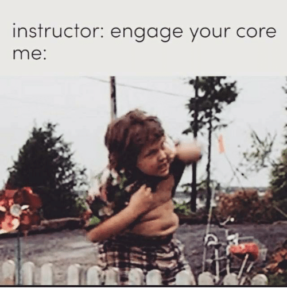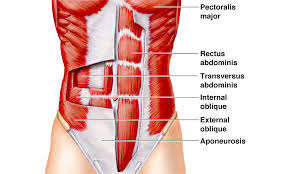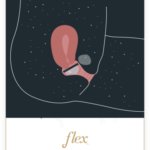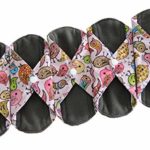What’s the Core?

Here is my summary of most people’s experience with “the core.”
You can easily find versions of this meme all over the internet. And isn’t it just spot on? Most people have a very hard time engaging their “core,” because they don’t know what the heck the core even is! It is an elusive term that is thrown around in many circles, including personal training, group fitness, and physical therapy. Haven’t you heard that pilates is good for the core? We will come back to that later. And there is another feature of this meme that rings true for postpartum women; after carrying a growing baby around for 9 months, we all look a bit more like a chubby, pubescent boy than a fitness model.
It is normal for the abdomen to take some time to return to its pre-pregnancy shape, even for women who are very active during their pregnancy. Not only do the muscles get stretched out, but the skin, fascia, and other soft tissue structures are all affected. That is why postpartum women tend to have a remaining “pooch” when they leave the hospital. (In addition to everything being stretched out on the belly, the uterus behind that soft tissue takes some time to contract and shrink back down to its normal size.)
Clearing Up Common Misconceptions
Most people think that the core is made up of the 6-pack muscles, aka the rectus abdominis. While these muscles can play a significant role in your postpartum health, there are other very important structures that help you stabilize your trunk. The rectus abdominis muscles are useful in helping you do a crunch or sit-up, and of course, in looking good on the beach. They cannot independently help you do more dynamic movements, though, like those that require rotation, side-bending, or a combination of directions of movement.
The core is actually made up of the major abdominal muscles, including the rectus abdominis and the obliques. It also includes the transversus abdominis, a thin sheath of muscles that surrounds your abdominal cavity and helps with the motion of corseting. (Think of trying to squeeze into some tight pants.) Then there are the multifidi muscles. These span along each side of the spine in short segments connecting neighboring vertebrae. They help to stabilize the back and pelvis before you take a step or lift your arms.
One often unthought of part of the core is the diaphragm, or the layer of muscle that separates the chest and abdominal cavities. Not only does it anatomically share a lot of connections with other core muscles, but its main function, to control breath, can dramatically impact your ability to engage other muscles in your body. The final part, a very important part, of the core is the pelvic floor. It is a collection of muscles that support the reproductive organs, the bowels, and the bladder. It also controls the ability to stop or allow the passing of feces and urine.
The Core and Your Postpartum Health
Every element of the core is affected by pregnancy and delivery. The abdominal muscles are frequently overstretched during pregnancy, called diastasis recti. Even if you don’t have diastasis recti though, your abs likely were stretched and elongated to a weakened state from the pressure from your uterus growing behind them. The transversus abdominis and multifidi muscles are likely not weakened from pregnancy, but the pull and load on them was very different while you carried your baby in utero. Since these muscles typically remain strong, they are a good tool to use in your postpartum recovery.
Next, the diaphragm is affected in pregnancy in a few ways. When you have a growing baby inside your uterus, it becomes increasingly more difficult to fully contract your diaphragm to expand your lungs. There is simply no room left at the inn, AKA your belly. Additionally, as your other core muscles tend to get weaker and stretched, you may notice more of a disconnect in your breathing pattern and movement. If you are not controlling your breath well, you are putting more pressure on the pelvic floor and other core muscles to manage your abdominal pressure.
Finally, the pelvic floor is the part of the core notoriously affected by pregnancy and childbirth. During pregnancy, extra pressure is put on these muscles due to weight gain. This can lead to their overstretching before a woman even goes into labor. Incidentally, having incontinence during pregnancy is highly correlated with having continued issues with incontinence after recovery from delivery. And any woman that has had a vaginal delivery can also attest to the strain and stretching of the pelvic floor that happens in those final stages of bringing your baby into the world.
How Can We Heal Our Core?
The core can be healed after all of the stretching and potentially even tearing from pregnancy and childbirth. Each component has targeted exercises that can rehabilitate it. But overall, good activities for postpartum women include:
-
Breathing Exercises:
- These are a good place to start. Try to focus on deep, diaphragmatic breathing where you inhale to expand your abdomen, then your chest, and then gently let your collar bones rise. As you exhale, you reverse this, allowing collar bones to drop, then chest and abdomen to draw in. Don’t just practice this is one position, like sitting on the couch. Mix it up and lay flat on your back, on your side, or with standing and moving around. Different positions will put varying amounts of resistance from gravity on your breathing muscles.
-
Walking, Sitting, and Standing with Good Posture:
- Start to focus on your daily functional movements. Bring your attention to feeling strong and stable in different positions. You don’t need to walk around crunching your abs, but you should try to notice if, when you are standing in the shower for example, you feel yourself turn off your ab muscles and fall into that overarched position through your back that you probably got used to in pregnancy.
-
Floor Exercises:
- When you feel that your breathing and posture have improved, you could begin working on heel slides, leg lifts, bridging, and marching on the floor or bed. ***Notice I did not say to start working on your crunches or sit-ups. These activities will likely overstrain your healing abdominals and put a lot of pressure on your pelvic floor.*** By incorporating some leg and arm movements into your routine, you will begin to build up the core’s ability to stabilize. Keep in mind though, it is super common to begin holding your breath as exercises get more challenging. Always bring your attention back to good breath control, and back off of the movement if you truly feel you can’t breathe through it.
-
Postpartum Yoga or Pilates:
- Eventually, you will probably want to return to more challenging activities. A good segway into returning to CrossFit, running, weight lifting, or spinning workouts may be to find a group fitness class specifically focused on postpartum recovery. Yoga, barre, and pilates studios will occasionally have these classes offered, where you know the instructor will be mindfully challenging you without asking too much of your recovering body. If the class is not specifically postpartum, the movements may include too much activation and strain on your abs, pelvic floor, or stability muscles. In that case, it is often better to find a good YouTube or online program to follow.







